Arguably the most impressive set of ruins in Thailand, Sukhothai Historical Park was awarded Unesco World Heritage status in 1991. Many of the temples here date back almost 800 years and with a picturesque natural setting it is a wonderful place to experience for a few days. The park is divided into 5 zones and although some of the best known temples and palaces are located within the central zone, there are gems to be found in most of the zones if you have the time and willingness to explore. Whilst the area attracts large numbers of tourists, the way the sites are spread out means it seldom feels crowded even on busy days. The Historical Park covers a wider area than many people anticipate so try to give yourself enough time (at least two days) if you want to fully appreciate the ancient sites of Sukhothai.
When visiting the central zone try to remember that this was once a thriving, living city. The central zone was the very heart of the Sukhothai kingdom and whilst the stone remains of the temples are impressive in their own right, the open land that can be seen today was once crammed with wooden houses where the citizens of Sukhothai lived and worked. The spacious green park-land dotted with ruins, lily ponds and countless Buddha statues is very photogenic, but visitors shouldn’t forget that this is not a theme park. No matter what state of disrepair some of the statues and temples are in, these are still holy sites and should be treated with respect.
Wat Mahathat
The highlight of the Central Zone is Wat Mahathat and the remains of the royal palace. This temple was completed in the 13th century and it doesn’t take much of a leap of imagination to picture this site in all its glory. Originally surrounded by brick walls and a moat, there are numerous Buddha images here in various poses of which some have been restored, but others are the originals from when the temple was completed.
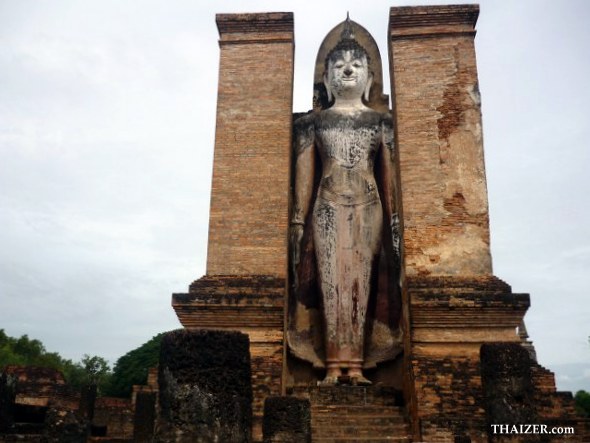 Standing Buddha at Wat Mahathat
Standing Buddha at Wat Mahathat
Wat Sa Si and Traphong Trakruan
Just to the north of Wat Mahathat is Wat Sa Si which is accessed by a wooden footbridge because it is situated in in the middle of a reservoir known as Traphong Trakruan. It’s a simple temple in a pretty setting with a bell-shaped chedi and a sitting Buddha image to the front.
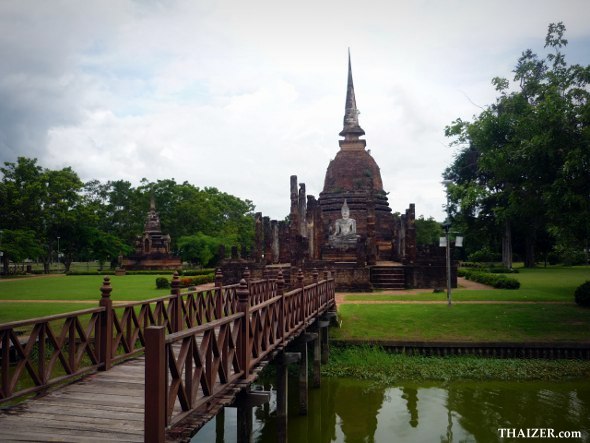 Wat Sa Si
Wat Sa Si
Wat Si Sawai
Easily recognised by its three distinctive Khmer-style prangs or towers, Wat Si Sawai was originally a Hindu temple constructed by the Khmers before it became a Buddhist shrine during the Sukhothai period. It’s a short walk away from Wat Mahathat and the southern gate entrance to the old city walls.
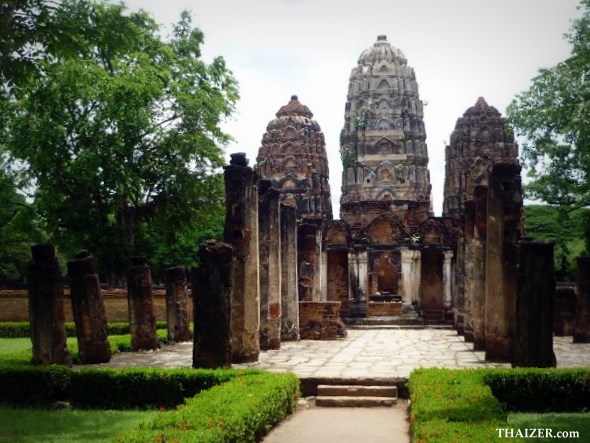 Wat Si Sawai
Wat Si Sawai
Lak Muang City Pillar
It may be a small shrine which is easy to miss, but the Lak Muang City Pillar would have been one of the most important locations in ancient Sukhothai. Every city in Thailand has a city pillar and you will notice the respect with which this ancient shrine is treated with fresh garlands of flowers placed here daily to accompany the miniature dancing figures.
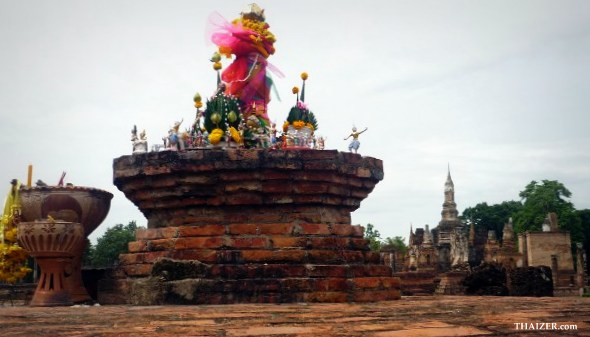 Lak Muang City Pillar
Lak Muang City Pillar
Ramkhamhaeng National Museum
Located close to the main entrance to the Historical Park, the Ramkhamhaneg National Museum is worth the effort if you are really into the history side of things and are spending at least a few days in the area. The entry fee for Thai people is 30 Baht but it’s 150 Baht for non-Thais.
Wat Traphong Tong
The Traphong Tong reservoir separates the museum from the only working temple in the Old Sukhothai area. The reservoir is called Traphong Tong (or ‘golden pond’) and it is this body of water that gives its name to the temple and is also central to the Loy Krathong celebrations that take place in Old Sukhothai. It is thought that the original floating of krathongs in Thailand first took place at this very spot before the idea would later spread nationwide to become the Loy Krathong festival. Some of the ancient remains of the original temple can still be seen, but more recent additions were made around 1920 and again in 2005. As well as laying claim to the origins of Loy Krathong, the temple is famous for a stone sculpture of the Buddha’s footprint which dates back to 1359 and is now housed here.
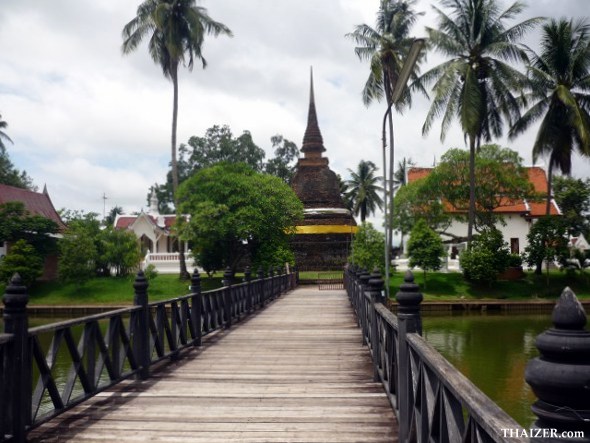 Wat Traphong Tong
Wat Traphong Tong
Statue of King Ramkhamhaeng
The monument to King Ramkhamhaeng is an important site where Thai people come to pay their respects to one of the most influential figures in Thai history.
The best-known attraction in the northern zone, and probably in the whole of Sukhothai, is the giant standing Buddha at Wat Si Chum. This is the famous talking Buddha image which has many legends and stories attached to it dating back to the heyday of the Sukhothai period. The other main temple in this zone is the Khmer-style Wat Phra Phai Luang.
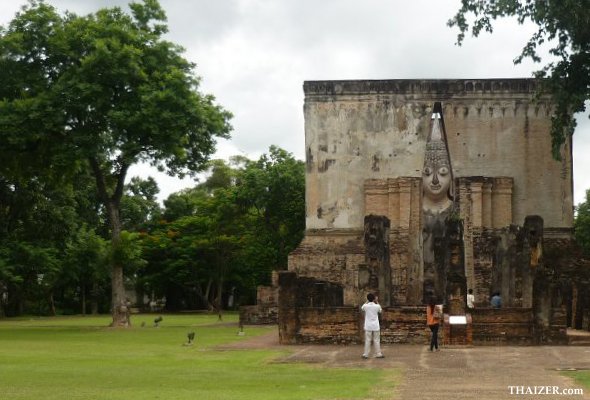 Wat Si Chum
Wat Si Chum
There are a few interesting ruins in the eastern zone of which Wat Chang Lom just beyond the boundary of the central zone is probably the most interesting. The temple get its name from the chedi which is supported by elephants sculpted into the base.
Just to the south of Namo Gate at the southern end of the former city walls lies the ruins of Wat Chetupon where you can still make out the outline of the walking Buddha and on the opposite side of the road is Wat Chedi Si Hong and Wat Ton Chan.
For those on whirlwind day visits, this is one zone that tends to get neglected which means that if you do have the time, you can almost have this area to yourself (especially in low season). There are numerous ruins here although in truth once you’ve been around the central zone they don’t seem as impressive. However there is some lovely countryside and with no traffic, riding a bicycle around here is a joy. The highlight of the western zone is Wat Saphan Hin situated on a hill that rises 200 metres above the surrounding plain. The name ‘Saphan Hin’ translates as ‘stone bridge’ and the well-preserved remains of this elevated slate stone path leads all the way from the bottom of the road to the top of the hill. This is the same path that former kings of Sukhothai would have taken to reach the wat at the top. There isn’t much of the original temple left, but there is a large standing Buddha and visitors who make the effort to get to the top are rewarded with fine views over the Sukhothai countryside.
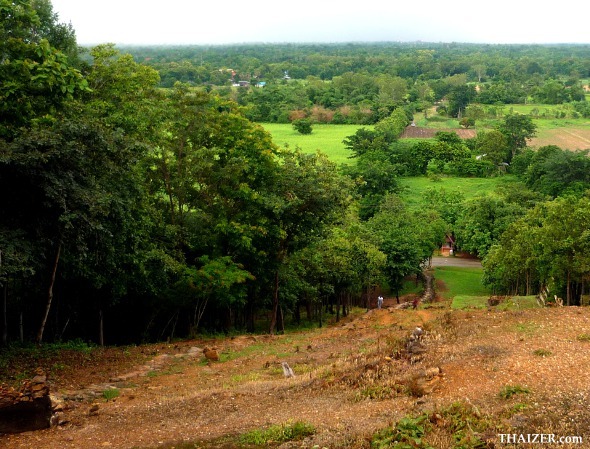 The view from the top of the hill at Wat Saphan Hin
The view from the top of the hill at Wat Saphan Hin
If you are staying in New Sukhothai, take a shared songthaew for 30 Baht which will drop you off close to the main entrance of the Historical Park. Alternatively you can negotiate a price for a tuk-tuk/samlor to take you to Old Sukhothai. These tuk-tuks/samlors can also be hired to take you around the Historical Park.
Admission to most of the zones is 100 Baht for non-Thais with an additional 10 Baht if you have a bicycle or 30 Baht if you are using a motorbike. Trams also run a shuttle service around the central zone although on my last visit in the low season there didn’t seem to be any demand for these. Instead, most visitors were using two-wheels with the occasional car or tuk-tuk/samlor also being used to take visitors around the main sites. If you don’t mind a bit of exercise, hiring a bicycle is a great way to explore the sights and the surrounding countryside. There are a couple of places close to the front entrance of the Historical Park that hire out bicycles with prices at around 30 Baht per day including a handy photo-copied map of the park. Audio tours are available for hire at the main ticket office for 150 Baht.
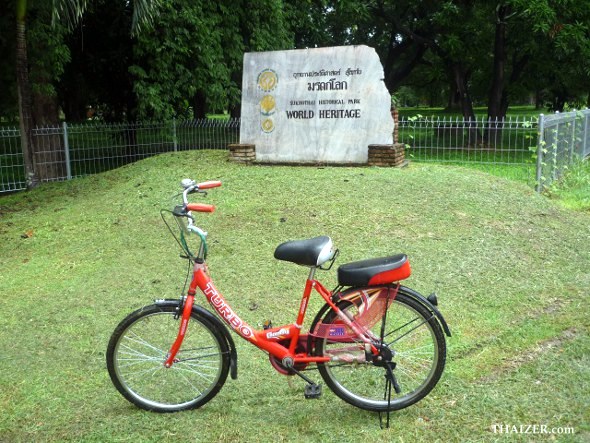
The main places to buy food and drink are located around the main entrance to the Historical Park so make sure you are stocked up on bottled water if you are venturing to the remoter outer zones and surrounding countryside. In the central zone of the park there is one coffee shop that sells drinks and snacks and it makes for a pleasant place to rest your legs or use the toilet. There is also a Thai massage place adjacent to the shop if your limbs are aching as a result of all that fresh air and exercise.
Find hotels and guest-houses in Sukhothai »
Read my personal review of At Home Sukhothai guest house »